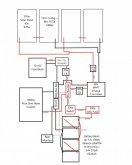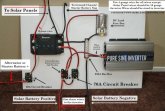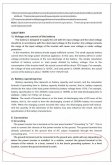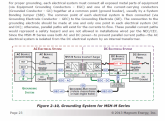Grounding seems like an important issue for all us DIY'ers who are not electricians and start tinkering with electricity, and it has been the hardest thing for me to get a clear answer to, at least for these types of mobile setups.
I have assembled a 24v mobile system based on the blueprints here, along with help from the book (which I purchased), and of course the rest of the internet.
This is a large system for a large step van (an old FedEx truck) mobile home conversion, and I want the ability to power a mini-split ac unit, all the standard household stuff, power tools and light welder usage, so I went as large as I could afford.
Main components include:
(4) 370w solar panels
(4) LiFePO4 12v 138ah batteries
80a MPPT charge controller
3000w Inverter
Attached is my diagram, which I am aware has some issues I will address below.
Now that I'm about to start electrical installation I am unclear on what to do about grounding. I have scoured the posts here and on other forums, tons of videos, and Will's book and can't find clear answers, at least that apply to my specific setup.
Yes, I have already watched all of the videos on the basics of circuits and grounding.
Yes, I have read the post with a similar title to this one, but still am unclear what to do since that setup is different.
Yes, I live in Florida with plenty of sun and plenty of lightning and intend to live in a large metal box.
Yes, I have read the manuals and NEC codes. Still confused.
I am NOT going to be charging off of the alternator and will NOT be using shore power. The system is intended to be completely separate from vehicle power.
The entire body and floor of the van is aluminum. The interior is insulated with polyiso board and spray, and is finished with wood paneling. All electrical components are mounted to a plywood board.
So here are my questions:
1. If grounded to the vehicle chassis, being that this system is 24v and the vehicle is 12v, will this difference in voltage lead to any issues?
2. Is there a difference in grounding to the chassis vs grounding to somewhere more convenient on the body?
3. If I do ground to the chassis, can the ground cable run off of the negative bus bar?
4. If the inverter and charge controller need to also be grounded as per their instructions, should those wires run back to the negative bus bar (which would run to the chassis), should they run to a close spot on the body of the vehicle, or should there be an entirely separate ground bus bar?
4. Do ground wires need to be solid wire, and what is the appropriate size for chassis, inverter, and charge controller wires?
5. Can/should the solar panel frames be grounded straight to the body somewhere on the roof?
6. Some people recommend not grounding to the vehicle chassis/body at all, citing the discrepancy between the vehicle's power and the sensitive components is a solar system. Is this insane and if not, how should protection be implemented?
Regarding my diagram, I realize that I may have over done it on some of the wire sizing since I sized for the surge of the inverter (6000w) vs it's continuous rating. I was also getting some conflicting info from different wire calculators, and of course every vanlifer has differing recommendations. Any help critiquing the wires and fuses of this system will be greatly appreciated.
I have spent a great deal of time trying to figure all this out, as even after years in fabrication and construction I'm still not an electrician. I'm not looking for a highly technical diatribe, I'm hoping someone out there has a similar setup and can say "do this and you're good to go," or that a bored electrician is wandering around this site and likes to explain stuff to adults as if they were 5 years old.
Thank you all, and thanks Will, this site is great.

I have assembled a 24v mobile system based on the blueprints here, along with help from the book (which I purchased), and of course the rest of the internet.
This is a large system for a large step van (an old FedEx truck) mobile home conversion, and I want the ability to power a mini-split ac unit, all the standard household stuff, power tools and light welder usage, so I went as large as I could afford.
Main components include:
(4) 370w solar panels
(4) LiFePO4 12v 138ah batteries
80a MPPT charge controller
3000w Inverter
Attached is my diagram, which I am aware has some issues I will address below.
Now that I'm about to start electrical installation I am unclear on what to do about grounding. I have scoured the posts here and on other forums, tons of videos, and Will's book and can't find clear answers, at least that apply to my specific setup.
Yes, I have already watched all of the videos on the basics of circuits and grounding.
Yes, I have read the post with a similar title to this one, but still am unclear what to do since that setup is different.
Yes, I live in Florida with plenty of sun and plenty of lightning and intend to live in a large metal box.
Yes, I have read the manuals and NEC codes. Still confused.
I am NOT going to be charging off of the alternator and will NOT be using shore power. The system is intended to be completely separate from vehicle power.
The entire body and floor of the van is aluminum. The interior is insulated with polyiso board and spray, and is finished with wood paneling. All electrical components are mounted to a plywood board.
So here are my questions:
1. If grounded to the vehicle chassis, being that this system is 24v and the vehicle is 12v, will this difference in voltage lead to any issues?
2. Is there a difference in grounding to the chassis vs grounding to somewhere more convenient on the body?
3. If I do ground to the chassis, can the ground cable run off of the negative bus bar?
4. If the inverter and charge controller need to also be grounded as per their instructions, should those wires run back to the negative bus bar (which would run to the chassis), should they run to a close spot on the body of the vehicle, or should there be an entirely separate ground bus bar?
4. Do ground wires need to be solid wire, and what is the appropriate size for chassis, inverter, and charge controller wires?
5. Can/should the solar panel frames be grounded straight to the body somewhere on the roof?
6. Some people recommend not grounding to the vehicle chassis/body at all, citing the discrepancy between the vehicle's power and the sensitive components is a solar system. Is this insane and if not, how should protection be implemented?
Regarding my diagram, I realize that I may have over done it on some of the wire sizing since I sized for the surge of the inverter (6000w) vs it's continuous rating. I was also getting some conflicting info from different wire calculators, and of course every vanlifer has differing recommendations. Any help critiquing the wires and fuses of this system will be greatly appreciated.
I have spent a great deal of time trying to figure all this out, as even after years in fabrication and construction I'm still not an electrician. I'm not looking for a highly technical diatribe, I'm hoping someone out there has a similar setup and can say "do this and you're good to go," or that a bored electrician is wandering around this site and likes to explain stuff to adults as if they were 5 years old.
Thank you all, and thanks Will, this site is great.









